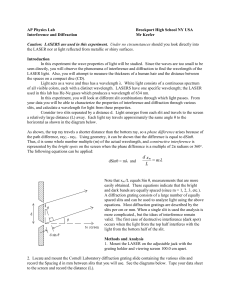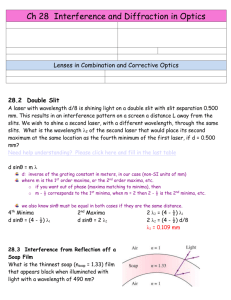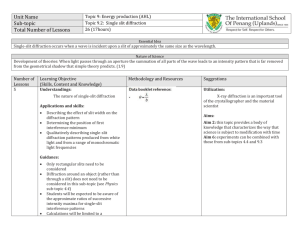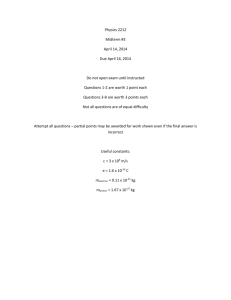Lab 8 - Interference, Diffraction, and Polarized Light
advertisement
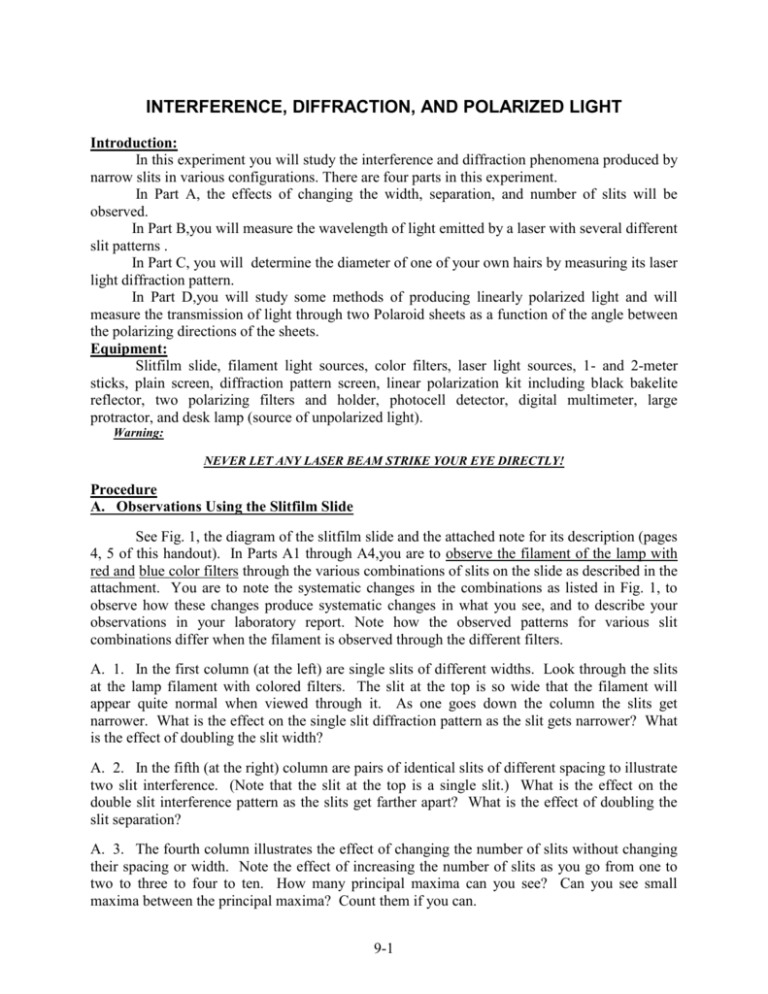
INTERFERENCE, DIFFRACTION, AND POLARIZED LIGHT Introduction: In this experiment you will study the interference and diffraction phenomena produced by narrow slits in various configurations. There are four parts in this experiment. In Part A, the effects of changing the width, separation, and number of slits will be observed. In Part B,you will measure the wavelength of light emitted by a laser with several different slit patterns . In Part C, you will determine the diameter of one of your own hairs by measuring its laser light diffraction pattern. In Part D,you will study some methods of producing linearly polarized light and will measure the transmission of light through two Polaroid sheets as a function of the angle between the polarizing directions of the sheets. Equipment: Slitfilm slide, filament light sources, color filters, laser light sources, 1- and 2-meter sticks, plain screen, diffraction pattern screen, linear polarization kit including black bakelite reflector, two polarizing filters and holder, photocell detector, digital multimeter, large protractor, and desk lamp (source of unpolarized light). Warning: NEVER LET ANY LASER BEAM STRIKE YOUR EYE DIRECTLY! Procedure A. Observations Using the Slitfilm Slide See Fig. 1, the diagram of the slitfilm slide and the attached note for its description (pages 4, 5 of this handout). In Parts A1 through A4,you are to observe the filament of the lamp with red and blue color filters through the various combinations of slits on the slide as described in the attachment. You are to note the systematic changes in the combinations as listed in Fig. 1, to observe how these changes produce systematic changes in what you see, and to describe your observations in your laboratory report. Note how the observed patterns for various slit combinations differ when the filament is observed through the different filters. A. 1. In the first column (at the left) are single slits of different widths. Look through the slits at the lamp filament with colored filters. The slit at the top is so wide that the filament will appear quite normal when viewed through it. As one goes down the column the slits get narrower. What is the effect on the single slit diffraction pattern as the slit gets narrower? What is the effect of doubling the slit width? A. 2. In the fifth (at the right) column are pairs of identical slits of different spacing to illustrate two slit interference. (Note that the slit at the top is a single slit.) What is the effect on the double slit interference pattern as the slits get farther apart? What is the effect of doubling the slit separation? A. 3. The fourth column illustrates the effect of changing the number of slits without changing their spacing or width. Note the effect of increasing the number of slits as you go from one to two to three to four to ten. How many principal maxima can you see? Can you see small maxima between the principal maxima? Count them if you can. 9-1 A. 4. The third column shows some coarse diffraction gratings with different numbers of slits, widths of slits and spacings of slits. Observe the effect of each change on the observed pattern and try to relate the changes in what you see to the changes in the slit combination. Note: adjacent patterns may differ in more than one way. In this Part A5,observe a lamp with no filter through the center diffraction grating. A 5. Observe the bright fringes. Note that the central bright fringe is white, but other fringes are not. Can you explain why this is so? B. Measurement of the Wavelength of Light Emitted by a Laser B. 1. Use the laser and plain screen and your slitfilm to measure the wavelength of the laser light. Mount the slitfilm slide in the holder so the beam from the laser passes through the central diffraction grating and observe the pattern on the screen. Determine yn, the distance between bright spots on the screen, and L, the grating-to-screen distance. Note: To increase the accuracy in your value of yn, measure the distance nyn from a bright spot to the nth bright spot beyond it and divide by n. Record both n and nyn. Estimate the errors in the distances L and nyn. B. 2. Make a similar measurement using a double slit instead of the diffraction grating. The same length measurements and error estimates are needed. C. Measurement of the Diameter of a Hair by Diffraction The method is described in detail in attachment (pages 6-7 of this handout),where Figure 2 shows the diffraction patteren.You will be provided with a copy of Fig. 2 on a card which is mounted on a 2-meter stick with a laser at one end. The scale of this copy is chosen so that when the diffraction pattern of a hair is projected onto the card so that the spacing of minima in the pattern matches the spacing of lines on the card, the distance L from the hair to the card in centimeters is numerically equal to the diameter of the hair in micrometers. One member of each group must provide a hair for the measurement. Mount the hair on the holder provided and mount the holder in front of the laser so the hair runs vertically and the diffraction pattern produced by the hair can be seen on the card. Move the card until the diffraction pattern exactly matches the pattern on the card. Measure and record the distance in cm from the hair to the card; this is the hair diameter in micrometers. D. Production and Measurement of Polarized Light Linearly polarized light is light in which the electric fields of the light waves are confined to a plane. Unpolarized light can be polarized (at least partially) by a number of processes including selective absorption in a material such as a Polaroid filter, reflection from a dielectric surface, and scattering. In this experiment you will observe light polarized by various methods and study its properties. Unpolarized light can be linearly polarized by passing it through a Polaroid filter (a special plastic polarizer) which transmits light with E vectors parallel to the transmission axis of the filter. A polarizer can also be used as an analyzer to determine the percentage and direction of linear polarization of light. If the transmission axis of the analyzer makes an angle with the direction of polarization of a light beam, then the component of the E vector which is transmitted is just E cos and the transmitted intensity I is given by the Law of Malus: I = Im (cos2). 9-2 When light is reflected from a smooth dielectric surface (See Fig.) it is linearly polarized with the E vector perpendicular to the plane of incidence. (See Halliday, Resnick & Walker, Fig. 3427.) In other words, the E vector of the reflected light tends to lie parallel to the plane of the reflecting surface. The degree of polarization varies with the angle of p n1 n2 reflection, but at an angle p, called the polarizing angle, the polarization is total or 100%. Brewster's law gives tanp = n2/n1 where n2 and n1 are the indices of refraction of the reflector and of the initial medium. D. 1. Observe through a Polaroid filter the unpolarized light from the desk lamp reflected from the bakelite mirror. By rotating the Polaroid, determine and record which orientation of the polaroid stops the E vector from passing through. Vary the angle of reflection by moving the light, the mirror, and the Polaroid. Make a rough measurement of Brewster’s angle p using the large protractor. Estimate the error in this measurement of p . D. 2. Measure the intensity of light transmitted through two sheets of Polaroid as a function of the angle between the transmission axes of the sheets. Set the Polaroids in the wooden holder. Look at the desk lamp through the two polaroids and observe how the intensity varies as you rotate one of the Polaroids. Connect the photocell to the multimeter (mA and COM), set the meter to 200 A, turn on the meter and verify that it responds to light. The meter reading will be proportional to the light intensity. Attach the photocell to the holder with a rubber band so it is directly behind the back Polaroid. Place the holder on the table and line up the scales on the Polaroids so the polarizing axes are aligned ( = 0˚) and 0˚ is at the bottom for both. Place the desk lamp near the front Polaroid so that light shines through the two polaroids and strikes the photocell. BE CAREFUL! DO NOT PUT THE LAMP TOO CLOSE TO THE POLAROIDS OR LEAVE IT THERE TOO LONG. IT CAN BURN THEM! Try to adjust things so the meter reads about 70 to 100 A (at least 40 A) when the polarizing axes of the two Polaroids are aligned. Turn off the light and record the meter reading for the background light intensity. Turn on the light and record the meter reading and the orientation of the front Polaroid. (If the polarizing axes are initially aligned so = 0˚,the angle by which the front Polaroid is rotated is the angle between the axes.) Rotate the front Polaroid by successive 15˚ intervals up to 120˚, thus changing in 15˚ steps: record and the meter reading at each step. Analysis: A. In your own words, summarize the observations you made in parts A 1. to A.5. of the Procedure section. You must relate your observations of the interference and diffraction patterns observed for various combinations of lines on the slitfilm slide with the data on the line combinations listed in Fig. 1. Try to be as quantitative as possible. Include descriptions of the differences in the patterns observed for red and blue light for the same slit combinations. Include answers to the questions asked in the Procedure section. B. The distance between slits, d, on the slitfilm is given for each line combination on Fig. 1. Use this information and your measurements of the lengths yn and L to calculate the wavelength of the laser light, for each of the two cases for which you made measurements. The appropriate equation is in your text. Use your estimates of the errors in yn and L and the rules of error 9-3 propagation to calculate a value for , the error in your value for in each case. C. What is the diameter and its error of your hair? D. 1. Use your measurement of Brewster’s angle p to calculate n2, the index of refraction of the Bakelite mirror. D. 2. Subtract the background meter reading from all your other meter readings. The resultant values should be proportional to the transmitted light intensity I. Plot I versus on a piece of graph paper. On the same graph plot I( = 0˚) (cos2) versus . Are your results consistent with the Law of Malus, I = Im (cos2)? Questions for the report: 1) From your observations of patterns for red and blue light in Part A., deduce whether red or blue light has a longer wavelength? Explain in your own words how this can be done. 2) Were your two determinations of in Part B.consistent? Which do you consider a better measurement? Why? The nominal value of the wavelength of light from a helium-neon laser is 632.8 nm. Are your results consistent with this value? Discuss possible sources of systematic errors in your measurements for Part B. Description of The Slitfilm Slide In this experiment, you will use the slitfilm slide, shown enlarged in Fig. 1 at the back of this writeup, to observe interference and diffraction phenomena produced by narrow slits. To use the slide, hold it with the long dimension vertical and the monogram in the upper right-hand corner. The slide should be as close to the eye as possible. Look through the slide at one of the lamps with color filters set up in the laboratory. As seen through the various combinations of slits, the filament of the lamp will appear to be spread out in a series of fringes. Actually the slits produce interference or diffraction patterns focussed and spread out on the retina of the eye. This makes the pattern appear spread out in space. The slit film slide will also be used to measure the wavelength of the monochromatic light emitted by a helium-neon laser. 9-4 9-5 Method of Measuring the Diameter of a Hair by Diffraction (This is adapted from an article in the American Journal of Physics by S. M. Curry and A. L. Schawlow, Department of Physics, Stanford University.) [Additional comments in brackets [] here and in the procedure have been made about items specific to this particular laboratory experiment.] If a fine wire or hair is placed in the beam of a small laser, a diffraction pattern is produced. We can determine the diameter of the hair by measuring the spacings of the maxima or minima. Indeed, the diffraction of laser light has been used in industry to measure diameters of fine wires as they are being produced, so that the wiredrawing machine can be regulated. A remarkably quick and easy measurement of the diameter can be obtained by matching the diffraction pattern to a calculated pattern. The form of the Fraunhofer diffraction pattern of a wire is the same as that of a slit of the same width in an opaque screen. That is, the intensity at an angle from the axis is: 2 I = Io sin / (1) where = (bsin )/ b is the slit or obstacle width, and is the wavelength. Equation (1) does not include background light from the room illumination or the intense undiffracted laser beam at the center of the wire's pattern. In this experiment, we are not at the far field distance for Fraunhofer diffraction of the laser beam aperture. It is, thus, best to consider only diffraction angles large enough to clear the main laser beam and then Eqn. (1) gives the diffractive intensity of either the wire or the slit. The diffracted light amplitudes from slit and wire from must be equal and opposite, since their open areas combined are equivalent to an obstructed plane, for which there is zero diffracted light amplitude outside the laser beam. When the diffraction pattern is displayed on a screen at a distance Lfrom the slit or wire, the point corresponding to the angle is at a distance xL tanfrom the axis. But for the first few orders of diffraction we can use the small angle approximation, sin tanxLThus, for a given wavelength, the intensity distribution in the diffraction pattern is a function of xbLThat is, the size of the diffraction pattern is proportional to L/b. 9-6 In the lower half of Fig. 2, the positions of the minima of diffraction intensity are marked. From Eqn. (1) these occur when ±±2, ±3, ... . Thus the distances of the minima from the center of the pattern are thus x±L/b, ±2L/b, ±3L/b, ... . For = 6.328 10-5 cm, b = 10-2 cm, L = 100 cm, the minima are at x± .633 cm, ± 2 .633 cm, etc.. Since the eye's response is roughly logarithmic, a better representation of the visual appearance is given by B = log (I + I1), where I1 is the background intensity. In the upper part of Figure 2, B is plotted for the diffraction pattern at a distance of 100 cm from a 100 aperture illuminated by a helium-neon laser ( = 6328 Å). I1 is taken arbitrarily to be 10-2 Io. In the lower part of the diagram the positions of the diffraction intensity minima are marked. [Note: This Fig. 2 is not drawn to the correct size for the dimensions given above.] The diffraction intensity pattern for a 100 diameter wire would be identical,except the undiffracted light from the outer parts of the laser beam would produce a brigtht central spot. The dark rectangle is intended to reduce glare from this central spot when an actual diffraction pattern is projected for comparison with the computer pattern. From a wire of different diameter the shape of the pattern is the same except that the horizontal scale of the pattern is altered. For a given wavelength, , the separation between minima is proportional to L/b. Alternatively, the separations of the diffraction pattern will match those in Figure 2 at a distance, L, proportional to the diameter b. To measure the diameter of a hair, it is convenient to mount a copy of Figure 2 on a card. [You will be provided with a figure of proper size on a card which is mounted on a 2-meter stick with a laser at one end.] The hair can be fastened by masking tape to the end of the laser housing so that it crosses the output beam. Alternatively, it can be mounted so that tension can be applied. By stretching a hair, it is quite easy to produce a change in its diameter large enough to change the diffraction pattern noticeably. [You will be provided with a mounting system for the hair. Do not try to stretch the hair.] A quantitative measure of the diameter is obtained by moving the card until the diffraction pattern matches the plot. The scale of [the copy you will use of] Figure 2 is chosen so that the distance L from the hair to the card, in centimeters, is numerically equal to the diameter of the hair in micrometers. This method is simple and quite accurately reproducible. DATA FOR EXPT 9: INTERFERENCE,DIFFRACTION & POLARIZED LIGHT 9-7 A. OBSERVATIONS: USING FILAMENT OF A LAMP WITH RED AND BLUE FILTERA1. Single -slit diffraction Pattern. A2. Double-slit Interference Pattern. A3. Multiple-slit diffraction and interfence Pattern A4. Diffraction Grating Pattern USING FILAMENT OF A LAMP WITH NO FILTER A5. Difraction Grating Pattern. B. Measurement of wavelength of laser light. B1. Using Central diffraction grating: width of slits, a= spacing between centers of slits , d= y fringe separation, grating to screen distance L = , error (y) ,L B2. Using double slit film: width of slits, a= 9-8 spacing between centers of slits , d= y fringe separation, double slit to screen distance L = , error (y) ,L C. Hair Diameter measurement distance from the hair to the screen in cm D= diameter of the hair d d , D D. Polarized Light data D1. Brewster’s angle pp D2. Malus’s Law angle between axes Intensity Intensity -background Background = 9-9



